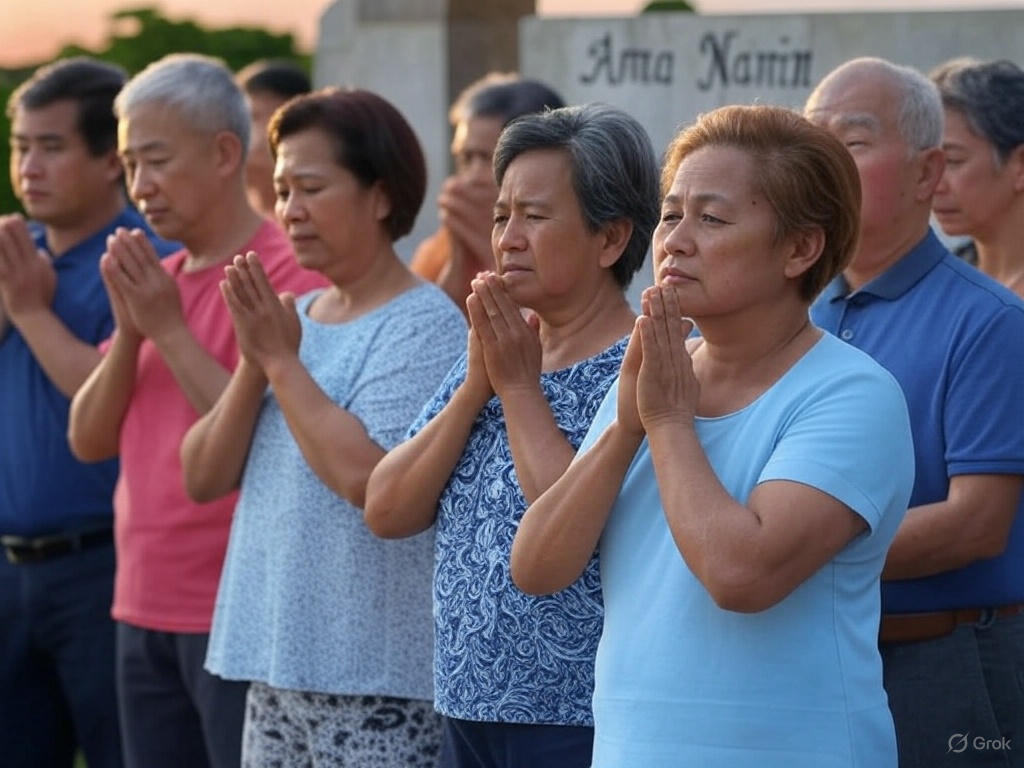
Below is an article about the “Ama Namin” prayer in Tagalog, written in English for clarity and accessibility. This article provides an overview of the “Ama Namin” prayer, its text in Tagalog, and its cultural significance.
The “Ama Namin” Prayer: A Pillar of Filipino Faith
In the Philippines, a predominantly Christian nation, prayer holds a special place in the hearts of its people. Among the most cherished and widely recited prayers is the “Ama Namin,” the Tagalog version of the Lord’s Prayer. Rooted in the teachings of Jesus Christ as found in the Bible (Matthew 6:9-13 and Luke 11:2-4), this prayer is a cornerstone of Catholic devotion and a unifying expression of faith for millions of Filipinos.
Origins and Significance
The “Ama Namin” is the Filipino translation of the “Our Father,” a prayer taught by Jesus to His disciples as a model for communicating with God. In the Philippines, where Tagalog serves as the basis for Filipino, the national language, this prayer has been adapted into the local tongue to make it accessible and meaningful to the masses. It reflects the deep religiosity of Filipinos and their desire to connect with the divine in their native language.
The prayer is recited in homes, churches, schools, and even public gatherings, showcasing its role as both a personal and communal act of worship. For many, it is memorized from childhood, passed down through generations, and ingrained in the fabric of Filipino culture.
The Prayer in Tagalog
Here is the full text of the “Ama Namin” as commonly recited in Tagalog:
Ama namin, sumasalangit Ka,
Sambahin ang ngalan Mo.
Mapasaamin ang kaharian Mo,
Sundin ang loob Mo
Dito sa lupa para nang sa langit.
Bigyan Mo kami ngayon ng aming kakanin sa araw-araw,
At patawarin Mo kami sa aming mga sala,
Para nang pagpapatawad namin sa nagkakasala sa amin.
At huwag Mo kaming ipahintulot sa tukso,
At iadya Mo kami sa lahat ng masama.
[Sapagkat sa Iyo ang kaharian, kapangyarihan, at kaluwalhatian,
Magpakailanman.]
Amen.
(Note: The bracketed portion, known as the doxology, is often included in Protestant recitations or certain Catholic settings, though it may not always be said in traditional Catholic Masses.)
Breaking Down the Prayer
Each line of the “Ama Namin” carries profound meaning:
“Ama namin, sumasalangit Ka” (“Our Father, who art in heaven”) acknowledges God as a loving, heavenly parent.
“Sambahin ang ngalan Mo” (“Hallowed be Thy name”) expresses reverence for God’s sacredness.
“Mapasaamin ang kaharian Mo” (“Thy kingdom come”) is a plea for God’s reign and justice to prevail.
“Sundin ang loob Mo” (“Thy will be done”) submits human desires to divine wisdom.
“Bigyan Mo kami ngayon ng aming kakanin sa araw-araw” (“Give us this day our daily bread”) asks for sustenance, both physical and spiritual.
“At patawarin Mo kami sa aming mga sala” (“And forgive us our trespasses”) seeks mercy for sins, paired with a commitment to forgive others.
“At huwag Mo kaming ipahintulot sa tukso” (“And lead us not into temptation”) requests strength against evil.
“At iadya Mo kami sa lahat ng masama” (“But deliver us from evil”) is a cry for protection.
The optional doxology, when included, serves as a triumphant affirmation of God’s eternal power and glory.
Cultural and Spiritual Impact
For Filipinos, the “Ama Namin” is more than just words—it’s a lifeline to faith. It’s sung during Mass, whispered in times of hardship, and chanted in moments of gratitude. The use of Tagalog makes it deeply personal, bridging the gap between the divine and the everyday lives of the people. In a country marked by resilience amid challenges like poverty, natural disasters, and historical struggles, this prayer embodies hope, trust, and surrender to God’s will.
The “Ama Namin” also reflects the Filipino value of bayanihan (community spirit). When recited together, it fosters a sense of unity, reminding Filipinos that they are part of a larger family under God’s care.
Modern Usage
Today, the “Ama Namin” remains a vital part of Filipino religious life. It is taught in schools, featured in popular media, and even set to music by artists seeking to inspire devotion. Whether in its traditional spoken form or as a melodic hymn, the prayer continues to evolve while retaining its timeless essence.
The “Ama Namin” is a testament to the enduring faith of the Filipino people. In its simple yet profound Tagalog verses, it encapsulates a worldview of dependence on God, forgiveness, and communal strength. As long as there are Filipinos who lift their voices in prayer, the “Ama Namin” will remain a sacred thread weaving through the nation’s spiritual tapestry.